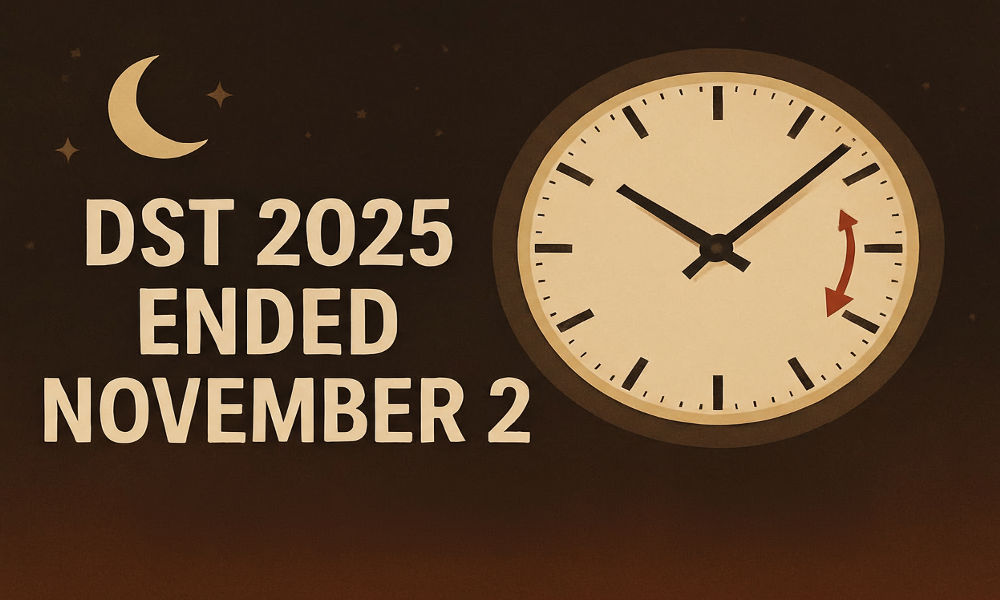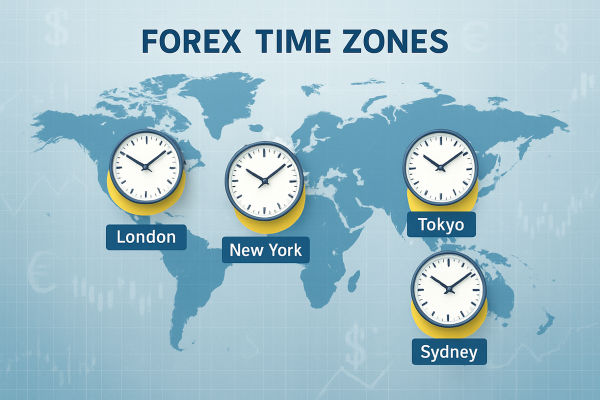Daylight Saving Time (DST) 2025 has just ended, marking the annual ritual of setting clocks back by one hour, signalling the arrival of shorter daylight hours and longer nights for many around the world.
As winter approaches, most regions that observe DST will revert to their standard time schedules. Looking ahead, DST in 2026 will begin on Sunday, March 8, 2026, in the U.S., and end on Sunday, November 1, 2026.
This article provides a clear and comprehensive overview of DST's end in 2025 and what to expect in 2026, including key dates, how DST affects trading and global markets, and the ongoing debate around the future of DST.
When Did Daylight Saving Time 2025 End?

In the United States and most of Canada, DST officially ended on Sunday, November 2, 2025, at 2:00 a.m. local time, when clocks were set back by one hour to 1:00 a.m.
This marked the second-earliest possible date for DST to end, as it always concludes on the first Sunday in November. That gives people an extra hour of sleep (the "fall back" effect).
In Europe (for example, the U.K. and EU), DST ends earlier, in 2025, on Sunday, October 26.
When Is Daylight Saving Time 2026?

Start of DST (2026): Sunday, March 8, 2026, at 2:00 a.m. local time → clocks move forward one hour ("spring forward").
End of DST (2026): Sunday, November 1, 2026, at 2:00 a.m. local time → clocks move back one hour ("fall back").
This schedule follows the U.S. convention established by the Energy Policy Act of 2005, running from the second Sunday in March to the first Sunday in November.
Countries and Markets Affected by DST
| Region |
DST 2025 End |
DST 2026 Start |
Market Notes |
| U.S. |
Nov 2, 2025 |
Mar 8, 2026 |
NYSE, CME, NASDAQ adjust; affects global data timing |
| U.K. / EU |
Oct 26, 2025 |
Mar 29, 2026 |
FX overlap with U.S. shifts temporarily |
| Australia |
Apr 6, 2025 |
Oct 5, 2025 |
Reverse cycle due to southern hemisphere |
| Japan, India, China |
No DST |
— |
No change; trade times shift relative to others |
For instance, Indian traders following U.S. earnings or FOMC events will find them starting one hour later during the post-DST period.
How DST Affects Global Financial Markets
DST changes do not just affect sleep cycles; they also shift the rhythm of global markets. Traders, brokers, and exchanges must adapt as time differences between key financial hubs (such as New York, London, Tokyo, Sydney) temporarily shift.
1. Time Zone Realignments and Market Hours
When one region ends or starts DST earlier than another, the overlap between trading sessions changes. For instance:
The London–New York overlap, crucial for forex trading, changes temporarily by one hour.
The Asia–Europe overlap also adjusts, influencing early-morning volatility in currencies such as USD/JPY or EUR/JPY.
Stock exchanges adjust open and close times in local time, but the relative time difference to other markets changes until all regions synchronise.
For example:
Between October 26 and November 2, 2025, London leaves DST one week before New York does, temporarily making the London–New York overlap one hour longer.
This typically increases short-term trading volume and volatility.
2. Impact on Trading Volume and Liquidity
Empirical research and broker data show that:
Trading volume spikes occur around DST transitions because of system adjustments and investor recalibration.
Some traders may reduce exposure ahead of the time change due to expected volatility or timing confusion.
Liquidity gaps sometimes emerge during the exact hour of the clock change (especially in forex markets open 24 hours).
For instance:
The foreign exchange market, from Monday to Friday, must accommodate server, quote, and settlement time adjustments, which can briefly alter execution speed or spreads.
3. Historical Market Behaviour During DST Changes
Historically:
The "spring forward" (March) shift is sometimes associated with slightly higher volatility, as markets reopen after shortened overlaps.
The "fall back" (November) shift can produce a minor liquidity lull, as traders benefit from a longer overlap and use the extra hour for system adjustments.
How Traders Can Prepare for DST Changes

Here's how investors and professionals can handle DST transitions effectively:
Check trading hours for all major exchanges and brokers beforehand.
Verify server times on your trading platform.
Avoid opening large new positions in the 24 hours before the time shift to avoid thin liquidity.
Adjust algorithms, bots, and notifications to ensure they utilise UTC or synchronise automatically.
Monitor volatility as time-zone overlap changes often affect spreads and execution speeds.
Plan for economic releases, confirm updated release times for key reports like:
For global traders, awareness is key: even one missed hour can mean missed opportunities or mispriced orders.
Why DST Might Change (And Debates Around Ending It)
In many places, the future of DST is under debate. Here are the main arguments and proposals:
Permanent time versus seasonal change: Some argue we should keep one time year-round (either standard or daylight) to avoid bi-annual disruption.
Legislative proposals: In the U.S., proposals like the Sunshine Protection Act have been introduced to make DST permanent, but they've stalled in Congress.
Public polls and sentiment: Surveys conducted in multiple nations indicate that more individuals favour discontinuing the biannual time change due to disruption and minimal energy benefit.
Health and safety arguments: Some studies suggest that the adjustments for DST lead to a temporary rise in accidents or health hazards.
Uniformity across regions: Regional mismatches (neighbouring jurisdictions with opposing DST rules) complicate schedules and cross-border trade, making elimination more attractive.
However, deploying such changes often requires legislative action, alignment between states/provinces, and technical readiness.
Frequently Asked Questions
1. When Is the 2026 DST Season?
Daylight Saving Time 2026 runs from March 8 to November 1 in the U.S.
2. Do We "Gain" or "Lose" an Hour at the End of DST?
At DST's end (fall), clocks are turned back, so you gain one hour. At the start (spring), you lose an hour.
3. Why DST Still Matters in a Digital Market
Even in 24-hour markets, DST continues to matter because:
Trading algorithms rely on time precision.
Cross-border settlements depend on synchronised clocks.
Market overlap hours remain key drivers of liquidity.
Conclusion
In conclusion, DST 2026 in the U.S. is scheduled to run from March 8 to November 1, 2026, following the long-standing "second Sunday in March to first Sunday in November" regime.
While the clock change might seem trivial, it temporarily shifts liquidity, volatility, and session overlap, creating both risks and opportunities for informed traders.
From forex and commodities to equities and derivatives, every second counts, and during DST transitions, those seconds move differently. Staying ahead of the time change is one of the simplest yet most powerful habits of a disciplined trader.
Disclaimer: This material is for general information purposes only and is not intended as (and should not be considered to be) financial, investment or other advice on which reliance should be placed. No opinion given in the material constitutes a recommendation by EBC or the author that any particular investment, security, transaction or investment strategy is suitable for any specific person.





























